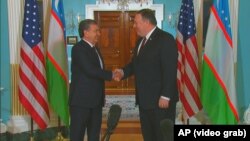The United States says new leadership in Central Asia and better interstate cooperation are opening up more opportunities for Washington to deepen ties with the resource-rich region.
Principal Deputy Assistant Secretary for South and Central Asian Affairs Alice Wells said on February 5 that the United States had updated its regional strategy to take into account new developments over the past five years.
"We absolutely see that we are in an era of new possibilities," Wells said a day after she returned from a trip to the region with Secretary of State Mike Pompeo.
The administration of President Donald Trump is seeking to expand U.S. influence in Central Asia -- a key land route between Europe and Asia filled with large oil and gas deposits -- in part as a counterweight to global rivals Russia and China.
The administration is also leaning on Central Asia for support as it tries to end the nearly two-decade-old war in neighboring Afghanistan.
Uzbek President Shavkat Mirziyoev, who took over the region's largest nation by population in 2016, has used his "visionary leadership" to drive internal reforms and interstate cooperation, Wells said.
The five leaders of Central Asia -- which also includes Kazakhstan, Kyrgyzstan, Tajikistan, and Turkmenistan -- met on their own in 2018 to discuss cooperation for the first time in a decade and followed that up with another meeting the following year, a development Wells called important.
"We have simply seen a sea change in attitude toward a regional identity," she said.
Lisa Curtis, who oversees Central and South Asian affairs at the White House National Security Council, said such interregional cooperation "would not have happened five years ago."
The officials said the United States was supporting projects that will help weave the region tightly together, like the formation of a unified electricity grid. It is also working with the five countries to standardize visa and customs procedures and lower nontariff trade barriers to boost cross-border relations and business.
They expressed hope for plans to export hydropower from Tajikistan and Kyrgyzstan to Afghanistan and Pakistan, which could help bring economic growth and stability to Afghanistan as it recovers from war, a key tenet of the U.S. strategy.
The U.S. officials said the overarching goals of Washington's strategy toward Central Asia remained the same -- to ensure the region is stable and free from dependency on any one power.
China's leverage over the region has increased as Beijing finances infrastructure projects that poorer countries like Tajikistan and Kyrgyzstan can struggle to pay back. Washington is offering assistance to the countries to determine whether infrastructure projects are worth the debt burden.
The officials said increased foreign investment into Central Asia will depend on the countries carrying out further reforms to strengthen the rule of law.
Curtis called on the leaders to improve democratic freedoms with "inclusive political systems including regular elections."
U.S. Says 'Sea Change' In Central Asian Cooperation Opens Up 'New Possibilities'
- By Todd Prince







